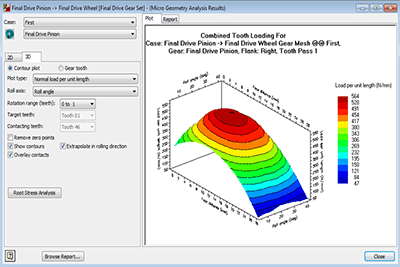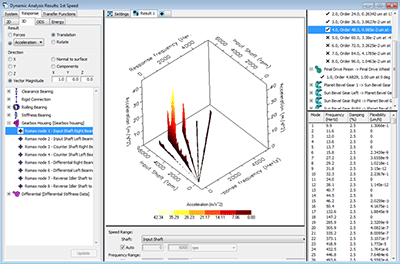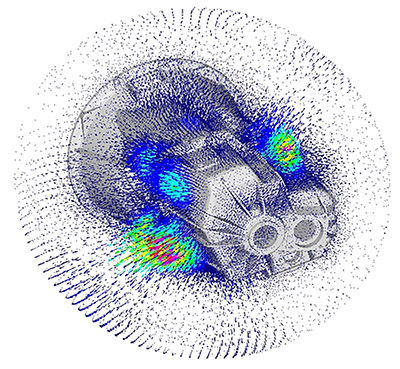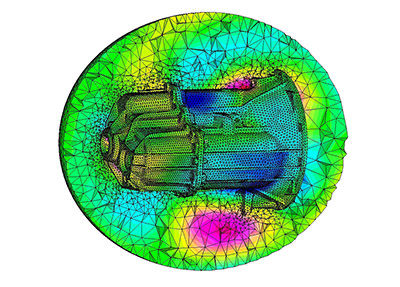In order to address this, it is imperative
that action is taken during the earliest
parts of the design and analysis
phase, widely identified as the key area
in which process improvements can be
made. Traditionally, the earliest stages
of production are carried out in isolation
with prototypes tested and problems
fixed later during the production process.
The fallout from this includes slow
development cycles, high development
costs, opportunity for miscommunication
and errors, and limited opportunity
for innovation.
Romax’s Right First Time approach
aims to update designs early on in the
design process, where changes can be made with comparative ease, and in turn
minimize late changes in the design and
production process. In order to achieve
this, the developers at Romax have identified
six critical development stages:
- Educate & Evangelize: Senior management
up to the highest levels need to
understand the benefits provided by
early analysis and its strategic importance
in design and development
- Assess: Firms must complete a full
audit of their design and development
process – to understand the scale of
the challenge and better target activity
- Identify: It’s important to find the
“quick win” areas where analysis can
add immediate value
- Implement: Organizations must
deploy appropriate analysis tools in
the area(s) identified – and do so with
commitment based on senior management
buy-in and sponsorship
- Focus: Firms must ensure they have
effective analysis tools at the concept
design stage that are able to consider
layout, center distance, gear and bearing
sizing, loads, packaging, NVH, etc.
- Improve: Firms must be prepared to
continuously monitor, update and
develop their processes – continuous
improvement will consolidate and
extend the gains being made
Providing more focused analysis during
the earliest planning stages enables
comparisons to be made with previous
designs and with competitive products
more easily. For the manufacturers, this
will help determine more realistic target
setting as well as allowing them to
ensure that any changes can be made
quickly and efficiently with minimal
long-term impact.
Addressing Demands for
Improved Performance
Modern-day consumers are conditioned
to constantly expect more power, better
performance, more features, a smaller
carbon footprint, and all for the same
cost or less. The result is increased pressure
to ensure that any potential design
targets and product criteria do not clash
Across an automotive transmission,
engineers have to balance conflicting
requirements of efficiency and noise,
while reducing weight without compromising
durability. All such requirements
are interdependent, and therefore
it’s imperative that before any actions
are taken, you are able to consider the
impact on other components within the
design chain.
One of the clearest examples of this
can be demonstrated when looking at
the hybrid and electric vehicle (HEV)
markets. As the demand for hybrid and
electric vehicles continues to grow, one
of the main challenges that manufacturers
struggle with is improving noise,
vibration, and harshness (NVH).
While the automotive sector has made
steps toward improving NVH — thanks
to improvements across design, analysis,
development and manufacturing
processes — challenges still exist for the
hybrid and electric vehicles sector. EV
and HEV design is altogether a more
complex process than designing traditional
drivetrains; EVs do not benefit
from the “masking” effect of the noise
from internal combustion engines, while
HEVs represent a particular challenge
because vibrations from both the engine
and the motor must be considered, along
with the interactions between them.
In order to address this, simulation
needs to be at the forefront when trying
to reduce NVH. Many manufacturers
work with finite element analysis and
multibody dynamics tools that try to
predict vibration response of the drivetrain
system. However, these processes
can prove to be so time-consuming that
they’re often only used too late in the
design process for the problems to be
resolved.
If manufacturers have access to software
that can simulate different solutions
in the earliest design phase before
they are produced, organizations can
save vast amounts of cost and time. To
support this it is important to ensure
companies have the right CAE tools and
development processes in place.
Putting this into Practice – GKN
Case Study
GKN Driveline has applied Romax
Technology software and consulting to
focus the optimization of gearbox efficiency
in electric motor-driven transmissions
without compromising noise
and durability.
After identifying the main contributors
to power loss, investigating how
changes to macro- and micro-geometry
would affect efficiency, and optimizing
the geared system in RomaxDesigner,
GKN Driveline manufactured the resulting
gears and evaluated experimentally
the driveline efficiency. Results showed
improvements across the speed and
torque range of interest of up to 2 percent
without compromising on durability
and NVH. This provided valuable
insights into how GKN Driveline continuously
initiates performance improvements
in its customer applications.

Figure 3 Tooth contact in RomaxDesigner.
- Click image to enlarge
Hybrids and EVs: a Market
Opportunity
GKN Driveline develops the latest driveshaft
and geared component technologies.
“During first hype of electrification four to five years ago, everyone talked
about quick introduction of batteryelectric
vehicles,” says Theo Gassmann,
vice president of Advanced Engineering.
“The reality was that the technology
wasn’t ready — for instance, battery technology
is too expensive — and customers
aren’t ready, particularly regarding range
limitations. So the EV market experienced
a slow start.” He says this led companies
to change strategy, embracing a
hybrid approach to develop the marketplace.
“GKN Driveline, as market leader in
driveline technology, is growing fast in
conventional and electrified driveline
systems. Coming from AWD systems,
we successfully launched transmissions
for hybrid and electric vehicles in the
last years. Transmission has not been
our core business but we utilized our
driveline expertise and technologies to
expand our portfolio successfully.”

Figure 4 Vibration response calculation in RomaxDesigner
- Click image to enlarge
Gassmann says transmission issues for
EV and HEV are broadly similar to nonelectric
applications: “Powertrain efficiency,
durability and NVH. Differences
come regarding the duty cycle and loads,
between coast and drive. The driveline is
different. And when you have to invest
in battery capacity, you don’t want to
waste energy in the transmission. The
biggest challenge is arguably NVH.
Missing masking noise from combustion
engine and lightweight-design leads to
an early focus on NVH improvements.”
The Value of the Right Analysis
System
Conventional methods to increase transmission
efficiency can have adverse
effects on durability and quiet running;
lack of engine noise in EVs renders current
design practices unacceptable. In
addition, the pressure to improve efficiency
of the eDrive gearbox in GKN
Driveline’s all-wheel drive hybrids
required a new approach. “We’ve worked
with Romax for several years, in a stepby-
step process that started in Japan
then moved into Germany and Sweden,”
says Dr. Artur Grunwald, supervisor of
Advanced Geared Systems Calculations.
“We saw the value of analyzing the
whole system, to identify where the
greatest benefits could be gained, then
working to balance efficiency, durability
and NVH across the entire system.
RomaxDesigner provided the accuracy in
modeling and analysis, and we worked
with Romax people on a project and
consulting basis to learn how to best use
the software and apply our engineering
expertise.
“We use RomaxDesigner for problem
solving and for system optimization
from concept to production design.
Perfect components don’t always equal
a perfect system when combined. That’s
why we use RomaxDesigner: it shows
where you can have the most impact and
where the benefits lie. It’s one of the few
software systems capable of this type of
system analysis. Our goal is, systematically,
to separate the useful parameters
from the possible in order to enable the
biggest benefit at acceptable cost level.”
Taking a Whole System Approach
to Optimize Design
Romax’s abilities to improve efficiency
were tested in a project that saw an
eDrive gearbox connecting an electric
drive to the rear axle of a PSA Peugeot
Citroen passenger car, with a conventional
internal combustion drive connected
to the front wheels. The original
gearbox was analyzed using
RomaxDesigner, which explored potential
improvements to gear geometries,
comparing predicted NVH and durability
with the original design.
GKN Driveline manufactured a redesigned
set of gears, with extensive tests
confirming overall efficiency improvements
and, in the all-important coast
condition that determines energy recuperation
performance, the 1–2 percent
gain across the speed and torque range
required. “The efficiency of the gearbox
was assessed by calculation of the component
losses from gears, bearings, seals
and oil churning,” Dr. Grunwald says.
“Efficiency results from the simulation
are compared against frictional
torque measurements taken during
testing under a range of torques and
speeds. The methodology used allows
advanced parametric studies to be carried
out in an all-in-one approach with
RomaxDesigner to consider the effect of
a wide range of design changes on efficiency
at the same time as durability and
NVH performance.”
He adds, “We also have several years’
experience of working with Romax people,
who have been extremely reliable
and professional. We clearly benefit from
that valuable experience. As a business,
we want to develop a common understanding
of simulation issues and use
consistent methodologies from concept
to production. Our requirement to take
a whole-system approach will increase
with future projects and applications,
and across different regions and product
ranges. The way RomaxDesigner integrates
with other software packages also
saves us time. Its ability to provide interfaces
and to share results for interpretation
by our engineers is another reason
we use it internationally.”
Gassmann adds, “We’re moving into
a new era of hybrids and electric cars.
Genuinely high-performance products
demand the effective application of system
know-how from concept to production,
so you can find the best possible
balance.”
Meeting the Demands of a New
World
Calls for innovation can be triggered by
a variety of factors. It could be from a
demand to keep up with competition,
a demand to incorporate technology
enhancements, or even a demand to satisfy
compliance and legislative changes.
In line with this, it is important to
understand the impact on not just the
internal design process, but also the need
to account for external variables.
Probably the best example of this can
currently be seen in Europe, notably the
EU’s plans for addressing growing carbon
emissions amongst all passenger
vehicles. Currently, the EU has put in
place a comprehensive legal framework
designed to reduce CO2 emissions from
new light-duty vehicles as part of efforts
to ensure it meets greenhouse gas emission
reduction targets under the Kyoto
Protocol and beyond. Car manufacturers
are obliged to ensure that new fleet cars
do not emit more than an average of 130
grams of CO2 per kilometre (g CO2/Km)
by 2015 and 95g by 2021.
The fallout of this has seen major
OEMs, led by some of the industry’s biggest
car manufacturers, actively developing
low-carbon, electro-mechanical
drivelines and vehicle technologies to
address consumer demands while still
meeting the requirements of the EU.
While it is reassuring to see positive
actions being taken, what often
isn’t considered is the impact of realworld
variables on those early design
phases. Earlier this year, a study carried
out by Romax in collaboration with
Loughborough University in the U.K.
revealed that fuel consumption in the
automotive industry can differ by as
much as 20 percent when comparing
real-world drive cycles to that of rig and
simulated tests based on legislative drive
cycles. This demonstrates the significant
variances which exist when it comes to
fuel efficiency.
The findings, which stemmed from
the impending EU legislations, were part
of a three-year investigation into the factors
that influence energy consumption
across hybrid electric vehicles, and how
real-world driving differs from legislative
test cycles. The interesting point of
note is that the findings clearly demonstrate
that while traditional design tools
used by manufacturers tend to focus on
efficiency against a single drive cycle,
they don’t account for the robustness of
a vehicle’s performance against a set of
drive cycles or against external factors
such as locational influence.
Tests are carried out in a very regimented
environment and rarely account
for outside influences
and as a result, the
data achieved from this
is rarely put to effective
use. In light of this, it
is imperative that organizations
start to make
the most of data streams
available to them, and
doing so at the earliest
points of the concept
design stages. Embracing
this would dramatically
smooth the transition
from one drive cycle to
another, with significant
cost reductions being
seen through greater fuel
efficiencies.

Figure 5 Mode shape analysis in RomaxDesigner.
- Click image to enlarge
As a final thought, it is
important to recognize
that OEMs have and will continue to use
a wide array of individual software tools
and methods to simulate and design
driveline components. The problem that
arises is that no matter how good these
standalone tools or individual analysis
processes are, they often fail to account
for unforeseen problems or external
variables, when combining components
into the complete system.
As demand for faster, smarter and
more cost-effective design increases, so
does the need to provide innovative simulation
tools, which can encapsulate the
entire driveline system, allowing for it to
be modeled and simulated quickly, accurately,
repeatedly and as early in the process
as you want.
As a company, this is what we at
Romax are committed to providing our
customers. Our solutions are designed
with the intentions of being integrated
into the overall design and development
process, with end-to-end tools designed
to address all elements from product
planning to manufacturing.
This quarter, Romax is announcing
its new comprehensive gear design tool,
embedded into its Concept product. This
will enable gear design to be part of a
fully integrated system-level design and
development process which includes
system durability, efficiency and NVH,
rather than being the standalone activity
which it often is today. See Romax at
booth #1402 at Gear Expo 2015, October
20–22 in Detroit.
About Author
Dr. Jamie Pears
Dr. Jamie Pears is
the Head of Product
Management at Romax
Technology. He has a M.Sc.
and Ph.D. in Physics from
Nottingham University,
UK. He joined Romax
Technology in October
2000 as a software developer working on
the RomaxDesigner analysis code and the
RomaxNVH software. Since then he has
been involved in engineering projects as the
NVH Team Leader, performing consultancy
for many worldwide customers. He has also
served as R&D Manager and Software Team
Manager. His current role involves setting the
overall direction of the Romax Technology
software products, communicating with
customers and directing the software
development team.













